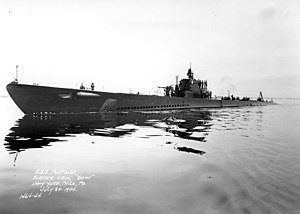United States Porpoise class submarine

USS Porpoise on 20 July 1944
|
|
| Class overview | |
|---|---|
| Name: | Porpoise class |
| Builders: | Electric Boat Company, Portsmouth Naval Shipyard, Mare Island Naval Shipyard |
| Operators: |
|
| Preceded by: | Cachalot class |
| Succeeded by: | Salmon class |
| Built: | 1933–1937 |
| In commission: | 1935–1945 |
| Completed: | 10 |
| Lost: | 4 |
| Retired: | 6 |
| General characteristics P-1 Type | |
| Type: | Diesel-electric submarine |
| Displacement: | 1,316 tons surfaced 1,934 tons submerged |
| Length: |
|
| Beam: | 24 ft 11 in (7.59 m) |
| Draft: | 14 ft 1 in (4.29 m) maximum |
| Propulsion: |
|
| Speed: |
|
| Range: |
|
| Test depth: | 250 ft (80 m) |
| Complement: | 54 -55 |
| Armament: |
|
The Porpoise class were submarines built for the United States Navy in the late 1930s, and incorporated a number of modern features that would make them the basis for subsequent Salmon, Sargo, Tambor, Gato, Balao, and Tench classes. Based on the Cachalots, enlarged to incorporate additional main diesels and generators, the Portsmouth boats were all riveted while the other boats were welded. In some references, the Porpoises are called the "P" class.
In general, they were around 300 feet (91 m) long and diesel-electric powered. Displacement was 1,934 tons submerged for the first four boats, 1,998 tons for the later ones.
The goal of a 21-knot fleet submarine that could keep up with the standard-type battleships was still elusive. The relatively high surfaced speed of 18 knots (33 km/h) was primarily to improve reliability at lower cruising speeds. A major improvement essential in a Pacific war was an increase in range from Perch onwards, nearly doubling from 6,000 nautical miles (11,000 km) to 11,000 nautical miles (20,000 km) at 10 knots (19 km/h). This allowed extended patrols in Japanese home waters, and would remain standard through the Tench class of 1944.
Although it proved successful with improved equipment beginning with the Tambor class of 1940, the diesel-electric drive was troublesome at first. In this arrangement, the boat's four main diesel engines drove only electric generators, which supplied power to high-speed electric motors geared to the propeller shafts. The engines themselves were not connected to the propeller shafts. For submerged propulsion, massive storage batteries supplied electricity to the motors. Problems arose with flashover and arcing in the main electric motors. There was also a loss of 360 hp (270 kW) in transmission through the electrical system. The Winton Model 16-201A 16-cylinder diesels also proved problematic, and were eventually replaced with 12-278As.
...
Wikipedia
